
5 SWOT Analysis Examples
A SWOT analysis is an incredibly valuable business tool that you can use at pretty much any time. Doing your own SWOT business competitor analysis can help you recognize where your business is doing well, where improvements are needed and what opportunities are available. SWOT analyses can be done for any sector or industry, making it a versatile business strategy tool. This article will walk you through what a SWOT analysis is, its benefits, and some great examples to help you conduct your own SWOT analysis.
What is a SWOT Analysis?
Before we talk about what is a SWOT analysis used for, we have to take a step back to look at what the term actually means. SWOT stands for Strengths, Weaknesses, Opportunities, and Threats. It’s used as a part of a business plan to help companies recognize their plus points, weaknesses, where they can grow, and what might be a risk.
Why You Should Write a SWOT Analysis
On a broad level, a SWOT analysis is useful for many reasons. First, it’s a good tool to identify ways to drive your own business forward, identify your business’s strengths and remain competitive. It is also worth mentioning you can do a personal SWOT analysis. Analyzing the same characteristics in yourself and that of your adversaries is a great way to get ready for any confrontation.
Other reasons to conduct a SWOT analysis include:
- Needed as part of a larger business plan for obtaining capital and to show overall business model.
- Capitalize on competitive advantages to build potential strategies such as a marketing plan, expand a product line and increase market share.
- Identify strengths and weaknesses to improve operations, cut rising costs, and create contingency plans for the future of the business.
- Used to identify opportunities and develop promotional strategies based on the organization’s strengths and minimize external factors that pose a risk to the business.
How Do You Write a Good SWOT Analysis?
Writing a good SWOT analysis is crucial for small businesses looking to expand quickly and keep an advantage over emerging competitors.
Conducting a SWOT analysis is about analyzing every aspect of a company and developing potential strategies accordingly. First, we’ll go through each of the components of a SWOT analysis and what to put down for each section to help you conduct a SWOT analysis.
Strengths
Your first step is to identify and list business strengths. This can include internal strengths, such as your unique selling points, teams, processes, technical expertise, tools, and other factors contributing to business success.
Then identify external strengths, such as supplier relations, advantage in the market over others, marketing, and online presence, additional services offered/value-adds, etc.
Weaknesses
This is the tough part of the four quadrants since it’s difficult to confront the strengths and weaknesses of a business objectively. But your main priority here is to identify the company’s weaknesses both internally and externally. Think of this as the building blocks to help you convert weaknesses into strengths.
This could include external environment factors such as pricing, competition, lowered demand, and more. It can also include internal weaknesses that negatively affect the business, such as lack of budget, small teams, etc.
Opportunities
Now that you’ve done a deep dive into your business’s strengths and your business’s weaknesses, it’s time to identify potential opportunities. Based on the strengths and weaknesses you’ve laid out, where does your company have the advantage?
Are there markets where you’re performing well that can be further expanded? Do you have a strong marketing strategy that you could ramp up to drive demand? Think of the external factors you’ve identified and where your business might have an opportunity to grow.
Threats
The threats part of SWOT analyses can also scare off many. Essentially, the goal here is to look at potential threats that could negatively impact your business. Again, this can include internal issues and external threats that you identify. Internal threats can include lack of staff, budgetary constraints, and other threats. External threats, as an example, can include markets you are not taking advantage of, negative reviews, strong competitors, and supplier issues.
4 SWOT Analysis Examples
When trying to come up with a SWOT analysis for your own business, it’s sometimes easier to see what others in your industry are doing. Before conducting a SWOT analysis for your company, you can look at some examples below to get some inspiration.
1. SWOT Analysis Example: Small Business
Regardless of industry, it can be difficult for a small business to identify weaknesses, opportunities, and threats. Here’s a great example to help you understand how to structure your SWOT analysis:
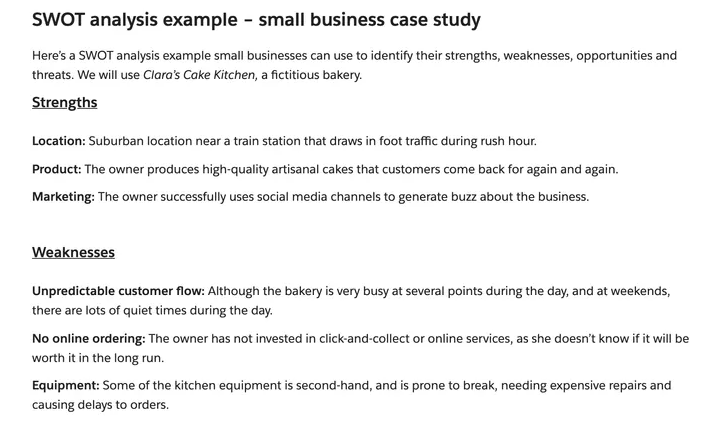
image: Salesforce
2. Marketing SWOT Analysis
For businesses focusing on improving one specific aspect of the business, such as sales or marketing, here is a marketing SWOT analysis example that you can use as a starting point for your own SWOT analysis.
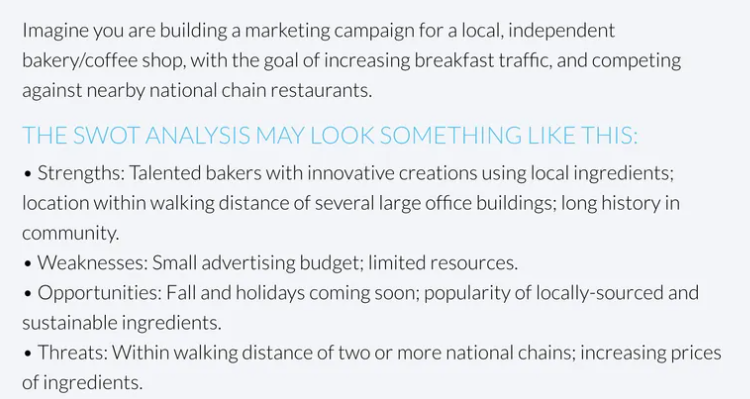
3. Company SWOT Analysis Example
For larger companies, it’s sometimes difficult to hone down and focus on strengths, weaknesses, opportunities, and threats because there are so many competing aspects. That’s why it can be helpful to look at a SWOT Analysis of a company example to help you structure your own.
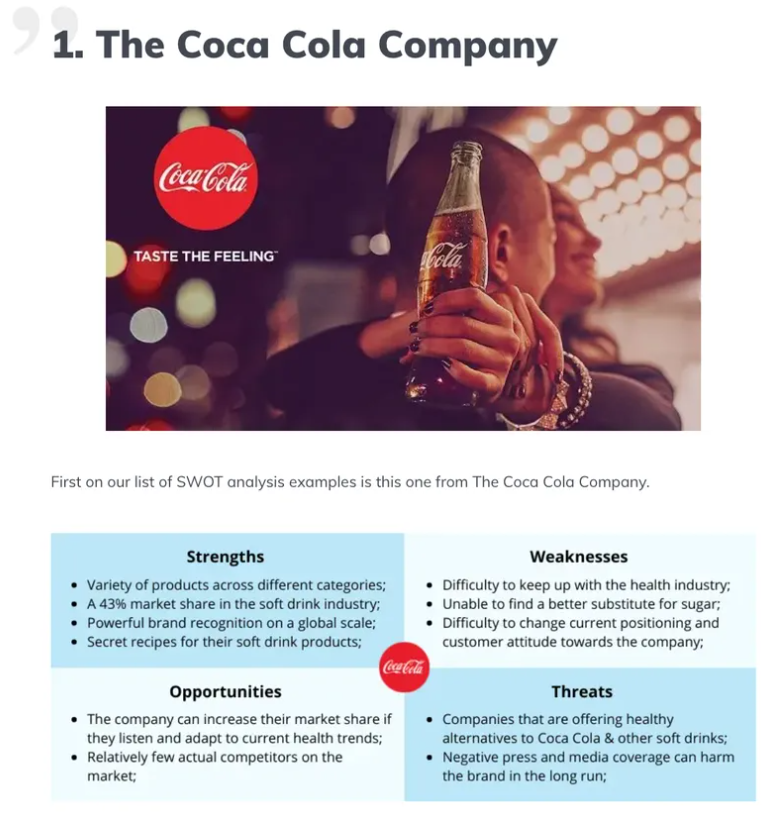
image: mktoolboxsuite
4. SWOT Analysis Example for a Restaurant
Food service businesses tend to have their own unique challenges, so identifying potential strategies is often difficult. However, using a Restaurant SWOT analysis example, you can build off it and create a SWOT analysis for your business that’s reflective of the market.
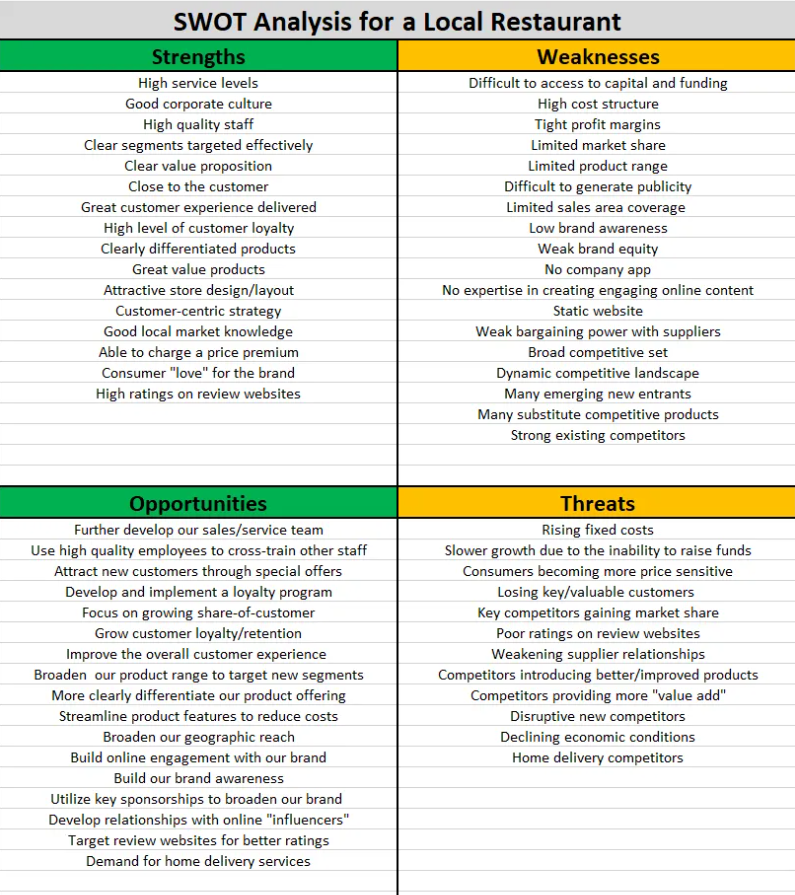
SWOT Analysis Template
Now that we’ve gone through some examples in different industries, how do you get started on creating a SWOT analysis of your own? Luckily, this kind of analysis is pretty easy to structure. You can create one using your computer or even just divide a piece of paper into four quadrants and start writing.
As a helpful tool, we’ve created a template for you below to get started with your SWOT analysis:
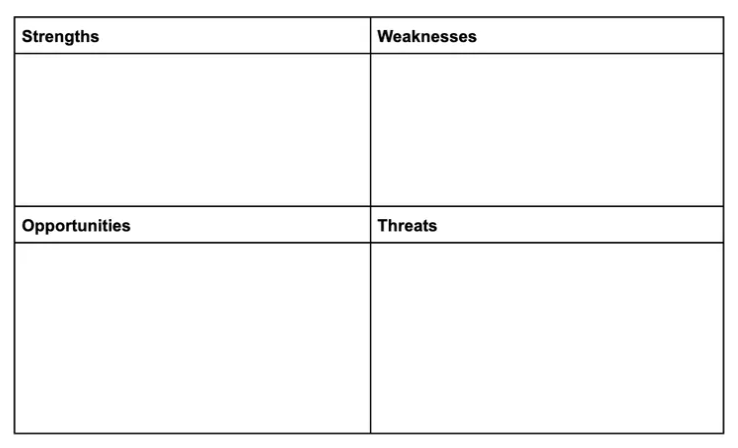
SWOT Analysis Tips
A strong SWOT analysis is about diving deep into your business, and collating all the information in an organized way. The more you’re able to tap into what makes your business unique and what needs to improve, the more actionable your SWOT analysis will be.
Here are some tips to ensure you’re getting the most of a SWOT analysis:
- Don’t be afraid: A good SWOT analysis is about confronting each part of the business: the good, the bad, and everything in between. Of course, it can be difficult to put down everything and objectively confront aspects of the business. However, it’s important to move past that feeling and be truly objective about your business – that will ultimately help it improve.
- Ask for feedback: To make sure your SWOT analysis truly covers everything, ask for feedback and suggestions. Involving a mix of team members, including more senior stakeholders and junior members, can help you spot problems you might not have known about.
- Be systematic: Sometimes, the easiest way to fill out a SWOT analysis is to have a system. That can mean going through internal issues across each quadrant first and then moving to external factors. Or you can choose to do two quadrants at a time, such as strengths and opportunities, if that is easier.
- Create timelines: In order for your SWOT analysis to be actionable, you need to create timelines alongside to meet your goals. For all the opportunities you identify, what is a reasonable timeframe to make them happen? For threats, think about how close or far threats are so you can prioritize action items more realistically.
What are internal and external factors in a SWOT analysis?
A good SWOT analysis will include both internal factors and external factors in each quadrant. An internal factor is an aspect the business has control of, such as people, processes, business culture, organizational structure, and more. External factors refer to things outside of business control. An external factor can include anything such as competitors, supply chain issues, demand, and more.
Source: Smallbiztrends
Patty Block, President and Founder of The Block Group, established her company to advocate for women-owned businesses, helping them position their companies for strategic growth. From improving cash flow…. to increasing staff productivity…. to scaling for growth, these periods of transition — and so many more — provide both challenges and opportunities. Managed effectively, change can become a productive force for growth. The Block Group harnesses that potential, turning roadblocks into building blocks for women-owned businesses.




